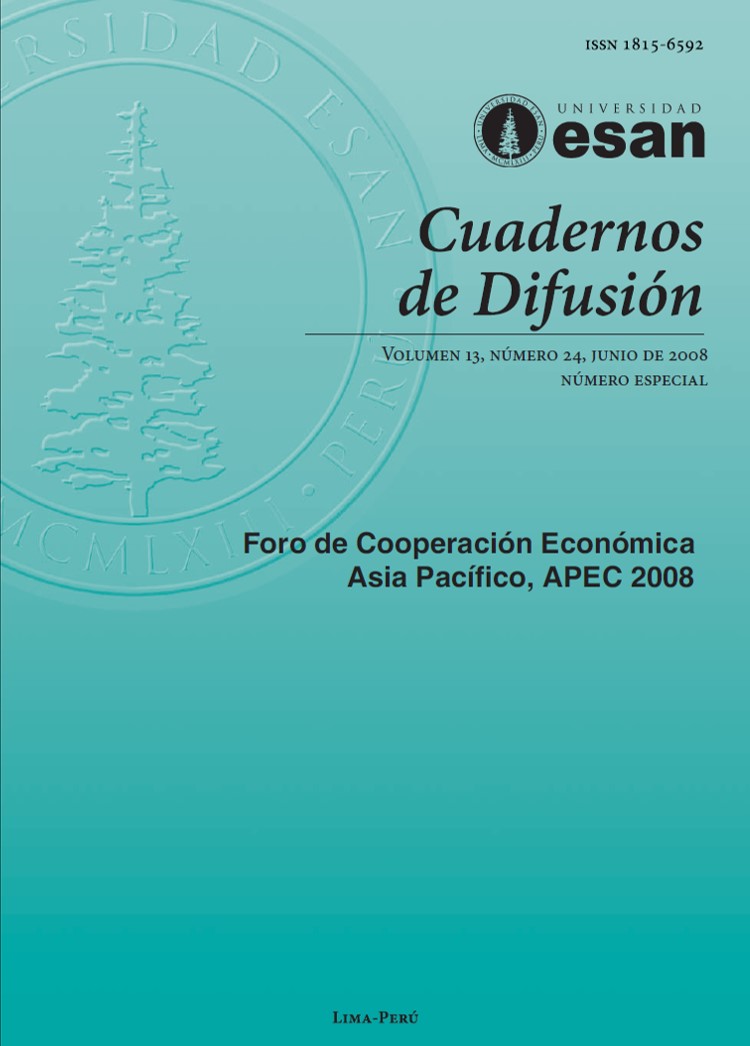Comercio potencial de servicios del Perú con el Asia Pacífico
DOI:
https://doi.org/10.46631/jefas.2008.v13n24.06Keywords:
trade in services, liberalization, opening, hub position, APEC member economiesAbstract
Services account for 47% of global output and, as per several studies conducted, the liberalization of their trade brings more advantages than trade in goods. Despite of this fact, there has been little research on the subject, and the defi nition of services has remained controversial. Peru sticks to global trend, as services represent 65% of GDP and 75% of EAP. Moreover, the development of tertiary sector is essential to attain a hub position. This paper is aimed at identifying the potential trade in services with Asia Pacifi c, based on trade and liberalization indicators –this region accounts for nearly 18% of current world trade–. It considers the commercial behavior of Peru, as well as that of Chile and Colombia, which are regarded as competitors in their condition of «access platform» to the Andean sub region. It is concluded that there are many possibilities to intensify relations with Asia Pacifi c and policy recommendations that should be taken into account by the Peruvian foreign policy are provided.
Downloads
References
BANGA, Rashmi. 2005. Trade and foreign direct investment in services: a review. Indian Council for Research on International Economic Relations. Working Papers N.º 154, New Delhi.
BELAUNDE, Pedro y BRYCE, Alfonso. 2005. Evaluación de los requisitos para el desarrollo del puerto del Callao como un hub portuario subregional de la costa oeste de América del Sur.
CAMINO, Claudia De. 2003. América Latina y el Caribe: series estadísticas sobre el
comercio de servicios 1980-2001. Cuadernos estadísticos N.º 29. Santiago de Chile: UN-Cepal, 123 págs.
CANTÍN, Laura y VARGAS, Karina. 2006. ¿Ventajas comparativas en la exportación de servicios? Análisis de los sectores de transporte aéreo y turismo.
CENTER FOR GLOBAL TRADE ANALYSIS. 2004. Global Trade analysis project.
COMISIÓN ECONÓMICA PARA AMÉRICA LATINA Y EL CARIBE (CEPAL). 2004. .
CONFERENCIA DE LAS NACIONES UNIDAS SOBRE COMERCIO Y DESARROLLO (UNCTAD). 2005. El comercio de servicios y sus repercusiones sobre el desarrollo.
FINDLAY, Christopher y WARREN, Tony (eds.) 2000. Impediments to Trade in Services: Measurement and Policy Implications. Londres: Routledge.
HILL, T.P. 1977. On goods and services. Review of Income and Wealth, Dec. 23, págs. 315-338.
HOEKMAN, Bernard. 1995. Tentative first steps. An Assessment of the Uruguay Round on Services. Policy Research Working Paper N.º 1455, May. Washington D.C.: Banco Mundial.
MATTOO, Aaditya; RATHINDRAN, Randeep y SUBRAMANIAN, Arvind. 2001. Measuring Services Trade Liberalization and its impact on Economic Growth. Policy Research Working Paper. The World Bank Development Research Group.
MATTOO, Aaditya y FINK, Carsten. 2002. Regional Agreement and trade in services: Policy Issues. World Bank Policy Research Working Paper.
McGUIRE, Greg. 2002. Trade in services-Market access opportunities and the benefi ts of
liberalization for developing economies. Policy issues in international trade and commodities study series N.º 19. United Nations Conference Trade and Development.
NIELSON, Julia y TAGLIONI, Daria. 2004. Services Trade Liberalisation. Identifying opportunities and gains. Feb. Working Paper N.º 1, OECD Trade Policy.
ORGANIZATION FOR ECONOMIC COOPERATION AND DEVELOPMENT (OECD). 2001. Quantifi cation of costs to national welfare from barriers to services trade: A literature review. Working Party of the Trade Comité.
ORGANIZACIÓN MUNDIAL DEL COMERCIO (OMC). 2003. Manual de Estadísticas del Comercio Internacional de Servicios.
VAN WELSUM, Desirée. 2003. International Trade in Services: Issues and Concepts.
WHALLEY, John. 2003. Assessing the benefi ts to developing countries of liberalization in service trade.
WORLD TRADE ORGANIZATION (WTO). 2006. Measuring trade in services
Downloads
Published
How to Cite
Issue
Section
License
Copyright (c) 2021 Journal of Economics, Finance and Administrative Science

This work is licensed under a Creative Commons Attribution 4.0 International License.











